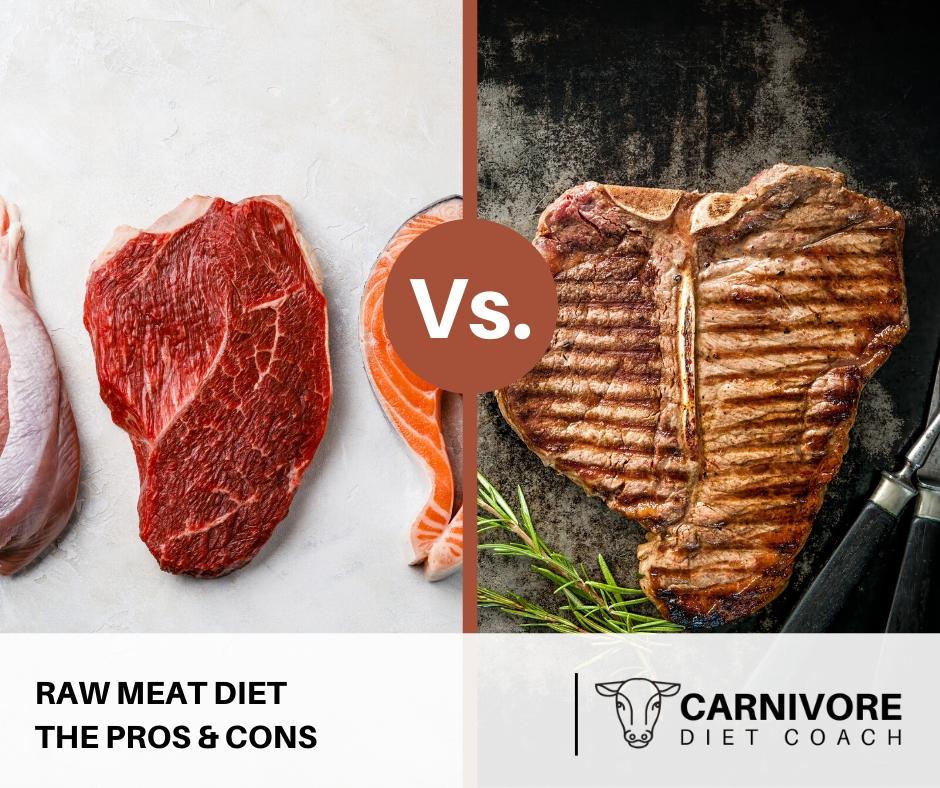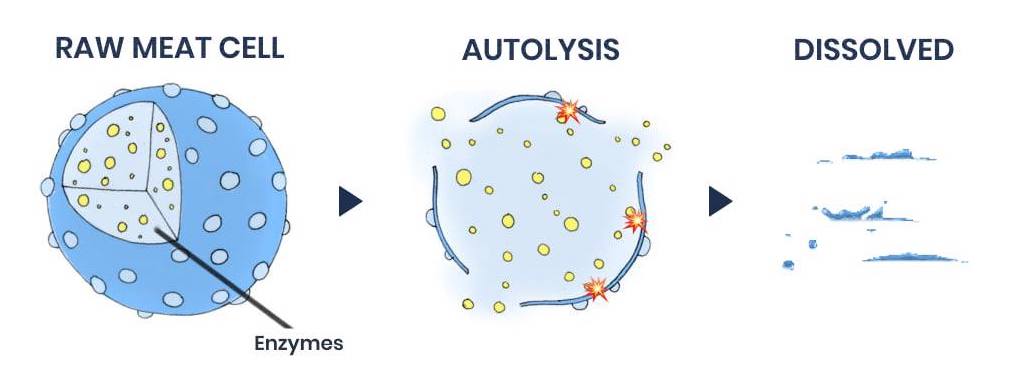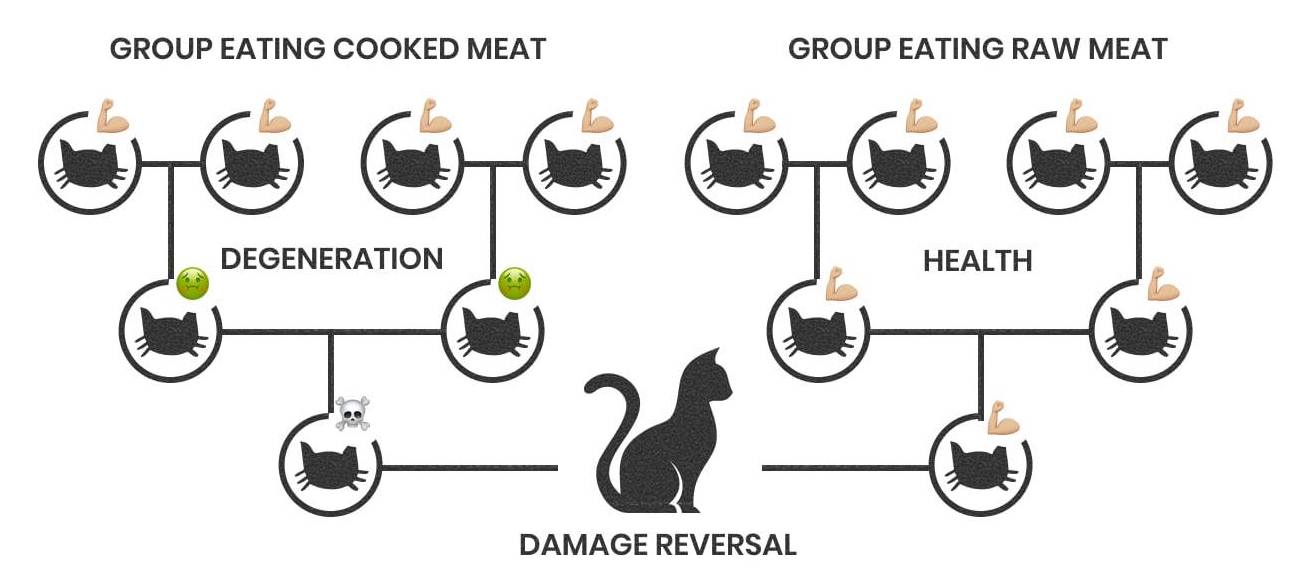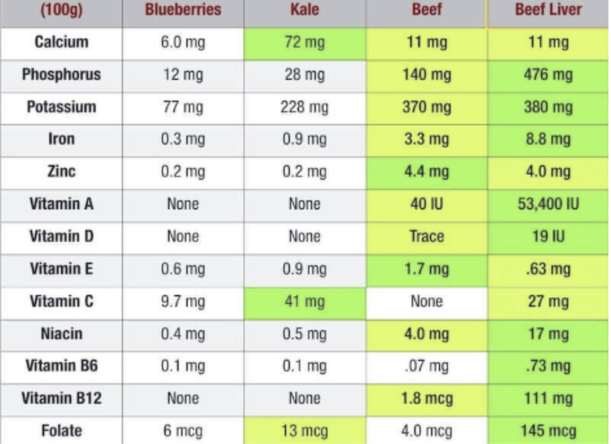|
THE COMPLETE
CARNIVORE DIET GUIDE
Learn how to lose weight, fix your gut and cure autoimmune symptoms with our free Carnivore Diet guide.
|
|
Raw Vs. cooked? That's the question for a lot of carnivores. Especially the more seasoned folk who have been on this way of eating for some time and noticed they feel pretty good rare steak. But is raw meat actually better for you? Are the nurtients more bio-available? Is it the ultimate carnivore way? Or is it all just a load of glorified extremists who have weird taste for blood and no regard for personal health? Let's find out. What is the raw meat diet? If you’re searching for a new way to modify your eating habits, the raw meat diet might be for you. As the name suggests, it consists primarily of raw meat, although some versions do include raw eggs, fish, and dairy too. Sometimes known as the raw primal diet, proponents believe that a diet of raw meat can enhance your health, but what exactly is it? A strict raw meat diet consists of eating raw meat and nothing else. Although pork and poultry should never be consumed raw, you’ll find raw steak, beef, lamb and venison plentiful on the raw meat diet. However, many people do consume other foods while on the raw meat diet. While raw dairy, fish, and eggs may not sound like the most appetizing thing on the menu, they can be eating alongside raw meat when you’re following this meal plan. Now you know exactly what the raw meat diet is, it’s time to get to the big question… Is it safe to eat raw meat? If you thought the reactions you got from people when you told them you were on the carnivore diet were bad, wait until you tell people you’re following the raw meat diet and you’re guaranteed to get asked the same question; is it safe? Contrary to popular belief, eating raw meat is safe, providing it’s prepared appropriately. Check out this guy who's been eating raw meat for years! Similarly, you’ll need to ensure your food is sourced from hygienic and reputable providers if you’re going to be adding raw meat to your diet. Many people assume that raw meat is dangerous because of the level of bacteria and/or parasites present in it. As the cooking process can kill bacteria and parasites, people presume that eating meat when it’s raw must be bad for you. However, the vast majority of meat-borne diseases occur because of inappropriate food preparation or poor quality meat. While the risk of bacteria being present in raw meat is higher than in cooked meat, choosing meat from a reputable source and preparing it properly can mitigate this risk. In fact, a good quality piece of raw meat only carries a minuscule risk of making you unwell, as long as it’s prepared properly. Of course, following a raw meat diet may not be the right choice for everyone. People with compromised immune systems may prefer to stick to a carnivorous diet without foraying into raw meat, for example. However, if you don’t have any underlying health issues, you source your meat properly and you prepare it well, there’s no reason to believe that consuming raw meat is bad for you. Raw Meat Eating - The Science People who practice raw meat eating consistently notice improved or eased digestion, feel lighter and have more energy. Why would this be? Surely cooking your food makes the nutrition more bio-available? THE RAW FROG EXPERIMENT In 1984, a Russian scientist named Alexander Ugolev did an experiment with 2 frogs — one cooked and one raw. Each frog was placed into a cup that was filled with hydrochloric acid, the acid present in most carnivore stomachs. The results were interesting to say the least. The raw frog completely dissolved while the pre-cooked frog remained mostly intact with only moderate changes to its surface. The reason is that the cells in the raw frog underwent "autolysis" which means "self-destruction" when put in the HCl. In other words, in the presence of hydrochloric acid, the raw frog digested itself. The cooked frog was unable to do this due to chemical changes caused by cooking. THE POTTENGER CAT EXPERIMENT In the 1930's, Francis Pottinger Jr conducted an experiment on more than 900 cats. SOme were fed raw meat and milk, other fed cooked and some fed a mixture of raw and cooked. He noted that the cats fed with raw foods consistently had better health, physically and mentally, than their cooked meat counterparts. Furthermore, the cats fed cooked food developed many issues which worsened with each generation of cooked food cat. The health issues were only reversed when the cooked fed cats were fed a raw meat diet and even then, it took several generations to restore full health. Frogs and cats is all well and good, but what about humans? THE WESTON A PRICE OBSERVATIONS In the 1930's, Weston A. Price, a dental surgeon, documented the health of indigenous tribes people both in their native environment and those who had moved to cities. He found that the indigenous people that ate their ancestral diet of animal foods, raw and cooked were free of most modern disease and had perfect dental development. While those in modern cities, on the then Standard American Diet had poor facial development and many diseases. He hypothesized that the rise in agriculture caused many vitamin decencies. So much so that he was able to reverse many diseases and change the facial structure by giving patients an animal based, raw food diet. The pros of a raw meat diet The high protein nature of a carnivorous diet can certainly boost your energy and minimize the risk of autoimmune illnesses, but a raw meat diet has other benefits too. Take a look at the pros of a raw meat diet to see if it’s right for you: ADDED NUTRIENTS Raw beef contains a high amount of B vitamins, for example, which promotes cell health, enhances brain function, increases energy levels and helps to prevent infections. In addition to this, fans of the raw primal diet argue that cooking meat makes it harder to digest, which implies that switching a from medium steak to steak tartare could have a positive impact on your gut. Furthermore, the cooking process tends to kill a significant number of enzymes that are present in raw meat. As many people believe that consuming some of these enzymes can be good for you, the increased number of enzymes present in raw meat could have a beneficial effect on your health. VITAMIN C Eating a carnivorous diet means you might miss out on your usual daily dose of vitamin C. Normally found in fruits and vegetables, you’ll need to find another way to consume this crucial vitamin when you’re following a meat-only diet. Fortunately, a raw meat diet enables you to get the vitamin C you might otherwise be missing. People assume that meat contains no vitamin C at all, but this isn’t the case. It’s actually the cooking process which eradicates the vitamin C from meat because it’s a heat-sensitive vitamin. And check out how much Vit C is in liver! When you consume meat raw, there’s no heat to get rid of the vitamin C. As a result, you can follow a carnivorous lifestyle while still getting your daily dose of vitamin C when you incorporate raw meat into your diet. REDUCED CARCINOGENS Cooking meat can produce a range of potentially carcinogenic compounds, including Advanced Glycation End-Products, Polycyclic Aromatic Hydrocarbons, and Heterocyclic Amines. While some scientists believe the number of carcinogens produced in the cooking process is negligible, others maintain they are a significant risk to health. Either way, a raw meat diet means you won’t be consuming them and won’t need to worry about the potential risk they carry. SIMPLICITY A raw meat diet is easy to follow and doesn’t require you to undertake complicated mathematical equations before you reach for a snack. If you’re fed up with counting calories, limiting your food intake and spending all your time thinking about your next meal, the raw meat carnivorous diet can be a welcome change. What’s more, you’ll free up some extra time when you don’t have to cook everything in advance, and you can drastically reduce the amount of washing up too! The cons of a raw meat dietLike all food plans, the raw meat diet can have some drawbacks, such as: DIFFICULTY SOURCING GOOD PRODUCE When you first embrace the raw meat diet, you may be wary of where you get your meat from. It’s good to be wary because finding a high-quality source of meat is critical. While it can be tricky to find a retailer you trust, once you get on the raw meat diet, you’ll find butchers, stores, and restaurants you can trust. COST For many people, the cost associated with a raw meat diet can be troublesome. Buying high-quality meat can be more expensive than you’d like, so there’s no real way to avoid the extra price tag. However, any diet should consist of premium quality foods, so the raw meat diet may not add as much to your shopping bill as you expect. UNWANTED ATTENTION If you don’t live in a culture where raw meat is routinely consumed, you’re going to be something of a novelty. Fortunately, the unwanted attention doesn’t last long. In today’s society, new lifestyle choices are becoming much more mainstream, so the raw meat diet really isn’t as out there as it first sounds. Plus, once people see the benefits it brings, they’ll be reaching for the sashimi and steak tartare themselves. With relatively few drawbacks and some major potential benefits, it’s easy to see why the raw meat diet is becoming increasingly popular. If you want to try a raw meat, carnivorous diet, check out these 5 ways to keep your meals safe and satisfying… 5 Tips to eat raw meat safely 1. FREEZE MEAT FOR 14 DAYS
When you freeze fish and meat, it kills the potentially harmful pathogens which are found in all raw meats and fish. By keeping your food frozen for at least 14 days, you’re getting rid of the potentially harmful extras and making your meals much, much safer. 2. EAT FRESH As soon as your meat and fish have defrosted or thawed, keep it very cold and eat it straight away. Allowing raw meat to sit at room temperature will let bacteria flourish, and this is where problems can arise. By keeping your meat very cold and eating is immediately after it’s thawed, you’re practicing proper food preparation and keeping your meals fresh. 3. EAT HIGH QUALITY If you’re unsure where your meat or fish has come from, don’t risk consuming it. Although it’s always important to source high-quality foodstuffs, it’s even more important when you’re eating a raw meat diet. On any carnivorous diet, it’s essential that you start by evaluating the care of the animals which are providing the meat you’re eating. As well as looking for providers who practice high standards of animal care, you’ll want to consume meat which comes from pastured animals only. When animals are grass-fed, it’s better for them and better for you. Many farms now offer direct-to-door food services, so you can source high-quality meat straight from your farmer. By cutting down the elements in the supply chain, you have more control over where your meat comes from and how it’s sourced. 4. TRY CITRUS It’s not unusual for chefs to sear raw fish in lemon or lime before it’s consumed, and this is something you can easily do at home. Citrus can kill the potentially harmful pathogens which could be found in raw meat or fish. By soaking in lemon and/or lime, you can sear the meat or fish and eradicate contaminates. As an extra measure for keeping your food safe, this is certainly worth doing. 5. ADD RAW EGGS Raw eggs can be a central component of the raw meat diet, so don’t be afraid to incorporate them. People tend to have the same fears about raw eggs as they do about raw meat but the same rules apply; source your eggs from a high-quality provider or farmer and there’s no reason they can’t be a nutritious and welcome addition to the raw meat diet. Put simply, raw meat is safe when correctly purchased and prepared and it can be an extremely healthy choice.
17 Comments
suzanne
12/11/2020 10:08:07 pm
Hi, I see conflicting information about whether freezing kills all parasites. I just read this on the Mayo Clinic website: Freeze meat for as long as seven to 10 days and fish for at least 24 hours in a freezer with a temperature of -31 F (-35C) to kill tapeworm eggs and larvae.
Reply
Anastasia
3/26/2021 01:48:07 pm
I know this is old but it may help others that come across it. If you are worried about parasites consume whole cloves after Eating. Cloves kill parasites. Also, garlic (raw ) kills parasites.
Reply
Marc Kelly
6/7/2021 05:39:52 am
Garlic is toxic and can kill cells entirely which is why they "kill" parasites. They wipe out everything. Just eat raw garlic and watch the entire content of your stomach end up in the toilet. So avoid it if you are Carnivore
Ed Albert
3/30/2023 06:35:46 am
1-You can salt your meat before placing it in the freezer...old technique to preserve all meats...rinse it before eating...you need salt, anyway. 2-We're talking about two or three cloves of garlic, nor a whole head...it's good at rising the good cholesterol and lowering the not-so-good...cheers!!
Gail
5/7/2021 04:02:21 am
My mother said that she got tapeworm from eating raw beef as a child back in the 1920s. She said that it was very painful to get rid of it. Just remember that all meat was high quality back in the 1920s because all of it was grassfed.
Reply
Trevor
6/6/2022 09:56:32 pm
Yes, but the meat processing was absolutely way less sanitary. Upton sinclairs account for example. Pros and cons of the old times. Obviously the food was much cleaner from toxins and chemicals. 2/2/2021 10:32:50 pm
I know when we have a cold winter here in Utah that there are a lot less insects, because their eggs die in the cold.
Reply
Ryan
8/7/2022 11:16:44 am
No, not really. The raw in the middle can be good depending on where you're sourcing the meat. A lot of the beneficial nutrients and bacteria are killed during the cooking process just as toxins and bad bacteria are if consuming factory farmed meat.
Reply
Antonio Abernathy
9/17/2022 12:43:18 pm
Animals are supposed to eat raw food. They are animals. They are supposed to eat raw food and the animals bodies are supposed to eat raw meats we are not. The body adapts to raw meat but it does not absorb nutrients from raw meat the same as cooked meats. This is a fact. All these test in this article make no common sense. The food we eat and the way we eat in modern society is tainted due to scientist that think they know everything and assume things and have no proof for it. The Raw food diet seems better because you cut everything out without finding the root of your problem. Most people around the world for centuries have been eating cooked meat with vegetables. Even natives cook their meat and they are healthier than us because they are not around as many toxins and do not take pharmaceutical drugs.
Reply
Stef
9/24/2022 06:10:03 pm
Humans are animals, no reason to believe we need to cook meat while other carnivores/omnivores/scavengers eat it raw...
Reply
Justin
1/30/2023 11:07:06 am
Natives are healthier than 'us'?
Reply
Scooty
3/13/2023 04:01:16 pm
He has zero logic to rebute against that. Humans are animals just like Stef said. We even have a lower stomach acidity than animals. We have sharp teeth evolved from it. The writings on the wall, the general public got played.
Jessy
3/29/2023 04:18:34 pm
Tell that to dying tribes of siberia or the nenets people for example. They do cook meet aswell, but when an animal is slaugtered the families eat a bloody soup of organs straight from the carcass. We are animals, even if you don't want to believe in it.
Reply
Joseppe
3/3/2023 10:13:46 am
"Don't use the power of fire" is the new "don't look up"
Reply
Penny Dabestani
7/12/2023 04:50:40 am
Does anyone ever eat Raw Chicken? If it’s frozen, does it kill all the bacteria and parasites in it as well? Why are Chicken and Pork considered dangerous to eat raw and other meats are considered safe?
Reply
Leave a Reply. |
Carnivore Diet Recipes & Meal PlansOur Trusted Partners
Popular Guides
|











